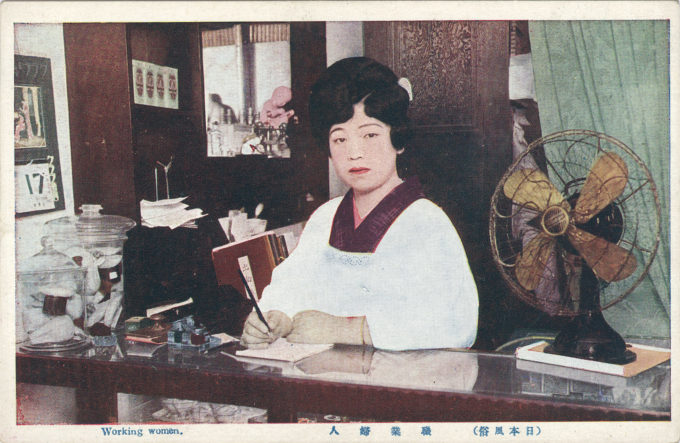
“Working women”, c. 1920, in a storefront retail setting – very likely in a street shop adjoining the family domicile. The Japanese caption (職業婦人) roughly translates to “career woman”.
See also:
“Modern Girl” (and “Modern Boy”), c. 1930
“In surveys, questionnaires, and news stories throughout the 1920s, numerous researchers probed the possible effects of employment on women’s ‘mission in life’ (tenbun) as wife and mother.
“They questioned whether a working woman would have lessened opportunity (or desire) to marry. They wondered, for that matter, whether her feminine virtue would still be intact when and if she did marry. They asked how married women could maintain two full-time jobs – one at the workplace, the other at home – without both spheres being shortchanged.
“In terms of national impact, they explored the possible effect of middle-class working wives and daughters on male unemployment, and they asked how the middle-class family could serve as a role model for the lower class if it, too, sent its women to supplement the earnings of the household head.
“… These and other questions posed in the 1920s suggest that the discourse on the working woman of the middle class touched at the heart of a much larger debate over social values, the institution of the family, and the gender role of women. Unresolved tensions surrounding these women’s entrance into the labor force disclosed a society in transition and struggling to reconcile changes wrought by modernization and urbanization with the late Meiji construction of women as good wives and wise mothers.
“… A comparison of the six categories used in the 1924 ‘Survey Regarding Working Women,’ one of many surveys released by the Tokyo Social Affairs Bureau … reveals that the discourse on the Modern Girl and the response to the Working Woman were part of the same social and economic history. While the six headings used by the Tokyo officials were teacher, typist, office workers, storekeeper, nurse, and telephone operator, the ‘Modern Girl Mental Test’ had also included bus conductors, café waitresses, and urban women producers of services which could not be classified as middle-class and who came from working-class backgrounds.”
– Recreating Japanese Women, 1600-1945, edited by Gail Lee Bernstein, 1991

